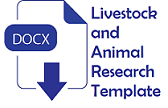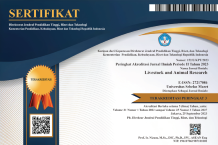Effect of ammoniated rice straw with urine and urea on the amount of digested crude protein, methane gas production and VFA profile of fat tail sheep
Abstract
Objective: This research aimed to find out the VFAs profile and methane gas production in fat-tailed sheep that fed rice straw ammoniated with commercial urea (T1), and rice straw ammoniated with urine (T2). Eight thin-tailed sheep aged 1.5 with an average body weight of 20 kg were used in this study. All the object studies were placed in individual metabolism cages. The feed concentrate used in this study was 2.3 % from the body weight of livestock, rice straw was ammoniated and water was given ad libitum, and feed was given twice a day at 7.00 a.m. and 4.00 p.m. Concentrate were given first, then 1 hour later the ammoniated rice straw was given. The drinking water was provided ad libitum.
Methods: This research was conducted in three stages, 1) total collection, 2) measure methane gas production, and 3) rumen fluid collection. A completely randomized design with 2 treatments and 4 replications was used in this study. After all data was collected, then it was analyzed using the Independent T-test using IBM SPSS Statistics 21 software.
Results: The results show no significance (P > 0.05) on rice straw ammoniated with commercial urea (T1), and rice straw ammoniated with urine (T2) for methane gas production (1,328.68±349.56 vs 1,463.95±215.41), VFA Total (40.74±13.09 vs 34.79±6.34), NH3 production (9.17±3.67 vs 8.78±2.94). It indicates that ammoniated using commercial urea or urine does not interrupt rumen fermentation.
Conclusions: It could be concluded that crude protein digestible, methane gas production, and VFAs profile especially the fermentation conditions in the rumen are not affected by ammoniation from commercial urea or urine.
Keywords
Full Text:
PDFReferences
- Steinfeld, H., P. Gerber, T. Wassenaar, V. Castel, M. Rosales, and C. de Haan. 2006. Livestock’s long shadow. FAO. Rome, Italy. Doi: 10.1890/1540-9295
- Storm, I. M. L. D., A. L. F. Hellwing, N. I. Nielsen, and J. Madsen. 2012. Methods for measuring and estimating methane emission from ruminants. Animals. 2(2):160–83. Doi: 10.3390/ani2020160
- Saputro, W. S., C. Hanim, L. M. Yusiati, Z. Bachruddin, and A. Pertiwiningrum. 2019. Effect of banana and mango waste product as malic acid source on methane gas production. IOP Conf. Ser. Earth Environ. Sci. 387(1):012026. Doi: 10.1088/1755-1315/387/1/012026
- Mitsumori, M. and W. Sun. 2008. Control of rumen microbial fermentation for mitigating methane emissions from the rumen. Asian-Australasian J. Anim. Sci. 21(1): 144–154. Doi: 10.5713/ajas.2008.r01
- Saputro, W. S., K. Efendi, and M. A. Darmawan. 2024. Hubungan protein kasar tercerna dan serat kasar tercerna terhadap produksi gas metan pada domba lokal jantan. Trop. Anim. Sci. 6(1):29–34. Doi: 10.36596/tas.v6i1.1344
- Hartadi, H., S. Reksohadiprodjo, and A. D. Tillman. 1990. Tabel komposisi pakan untuk Indonesia. Gadjah Mada University Press, Yogyakarta.
- Hidayat, R., E. Purbowati, M. Arifin, and A. Purnomoadi. 2009. Komposisi kimia daging sapi Peranakan Ongole yang diberi pakan jerami padi urinasi dan level konsentrat yang berbeda. Semin. Nas. Teknol. Peternak. dan Vet. Bogor. pp. 246–51.
- D. Tillman, A., H. Hartadi, S. Reksohadiprodjo, S. Prawirokusumo, and S. Lebdosoekojo. 1998. Ilmu makanan ternak dasar. 5th ed. Gadjah Mada University Press, Yogyakarta.
- Purnomoadi, A., J. Wahyudi, E. Rianto, and M. Kurihara. 2003. Pengaruh ampas kecap terhadap retensi dan konversi energi kerbau dara yang mendapat pakan basal rumput gajah. J. Indones. Trop. Anim. Agric. 112–7.
- Filípek, J. and R. Dvořák. 2009. Determination of the volatile fatty acid content in the rumen liquid: comparison of gas chromatography and capillary isotachophoresis. Acta Vet. Brno. 78(4):627–633. Doi: 10.2754/avb200978040627
- L. Chaney, A. and E. P. Marbach. 1962. Modified reagents for determination of urea and ammonia. Clin. Chem. 8(2):130–132. Doi: 10.1093/clinchem/8.2.130
- Zaman, M., L. Heng, and C. Müller. 2021. Measuring emission of agricultural greenhouse gases and developing mitigation options using nuclear and related techniques: Applications of nuclear techniques for GHGs [Internet]. Meas. Emiss. Agric. Greenh. Gases Dev. Mitig. Options using Nucl. Relat. Tech. Appl. Nucl. Tech. GHGs. Springer International Publishing. Doi: 10.1007/978-3-030-55396-8
- Oh, J., H. Cho, S. Jeong, K. Kang, M. Lee, S. Jeon, H. Kang, and S. Seo. 2024. Effect of dietary crude protein level of concentrate mix on growth performance, rumen characteristics, blood metabolites, and methane emissions in fattening hanwoo steers. Anim. 14(3):469. Doi: 10.3390/-ani14030469
- Hynes, D. N., S. Stergiadis, A. Gordon, and T. Yan. 2016. Effects of concentrate crude protein content on nutrient digestibility, energy utilization, and methane emissions in lactating dairy cows fed fresh-cut perennial grass. J. Dairy Sci. 99(11):8858–8866. Doi: 10.3168/jds.2016-11509
- Kidane, A., M. Øverland, L. T. Mydland, and E. Prestløkken. 2018. Interaction between feed use efficiency and level of dietary crude protein on enteric methane emission and apparent nitrogen use efficiency with Norwegian Red dairy cows. J. Anim. Sci. 96(9):3967–3982. Doi: 10.1093/-jas/sky256
- Arndt, C., J. M. Powell, M. J. Aguerre, and M. A. Wattiaux. 2015. Performance, digestion, nitrogen balance, and emission of manure ammonia, enteric methane, and carbon dioxide in lactating cows fed diets with varying alfalfa silage-to-corn silage ratios. J. Dairy Sci. 98(1):418–430. Doi: 10.3168/jds.2014-8298
- Yan, T. and C. Mayne. 2007. Mitigation strategies to reduce methane emission from dairy cows. In high value grassland: providing biodiversity, a clean environment and premium products. Proc Br Grassl Soc Conf. Staffordshire, UK: British Grassland Society (BGS): Penkridge, UK. pp. 345–348.
- Greening, C., R. Geier, C. Wang, L. C. Woods, S. E. Morales, M. J. McDonald, R. Rushton-Green, X. C. Morgan, S. Koike, S. C. Leahy, W. J. Kelly, I. Cann, G. T. Attwood, G. M. Cook and R. I. Mackie. 2019. Diverse hydrogen production and consumption pathways influence methane production in ruminants. ISME J. 13(10):2617–2632. Doi: 10.1038/s41396-019-0464-2
- Fuchs, G. 1994. Variations of the Acetyl-CoA pathway in diversely related microorganisms that are not acetogens. Acetogenesis. 507–520. Doi: 10.1007/978-1-4615-1777-1_19
- Gonzalez-Garcia, R. A., T. McCubbin, L. Navone, C. Stowers, L. K. Nielsen, and E. Marcellin. 2017. Microbial propionic acid production. Fermentation. 3(2):1–20. Doi: 10.3390/fermentation3020021
- Wang, K., X. Nan, K. Chu, J. Tong, L. Yang, S. Zheng, G. Zhao, L. Jiang, and B. Xiong. 2018. Shifts of hydrogen metabolism from methanogenesis to propionate production in response to Replacement of forage fiber with non-forage fiber sources in diets in vitro. Front Microbiol. 9:1–12. Doi: 10.3389/fmicb.2018.0276
- Singh, V., G. D. Lee, H. W. Son, H. Koh, E. S. Kim, T. Unno, and J. H. Shin. 2023. Butyrate producers, “The Sentinel of Gut”: Their intestinal significance with and beyond butyrate, and prospective use as microbial therapeutics. Front Microbiol. 13: Doi: 10.3389/fmicb.2022.1103836
- Ungerfeld, E. M. 2020. Metabolic Hydrogen flows in rumen fermentation: principles and possibilities of interventions. Front Microbiol. 11:589. Doi: 10.3389/fmicb.2020.00589
- Lobiuc, A., N. E. Pavăl, I. I. Mangalagiu, R. Gheorghiță, G. C. Teliban, D. Amăriucăi-Mantu, and V. Stoleru. 2023. Future antimicrobials: natural and functionalized phenolics. Molecules. 28(3):1114. Doi: 10.3390/molecules28031114
- Patra, A., T. Park, M. Kim, and Z. Yu. 2017. Rumen methanogens and mitigation of methane emission by anti-methanogenic compounds and substances. J. Anim. Sci. Biotechnol. 8:1–18. Doi:10.1186/s40104-017-0145-9
- Dewhurst, R. J. and J. R. Newbold. 2022. Effect of ammonia concentration on rumen microbial protein production in vitro. Br J Nutr. 127(6):847–849. Doi: 10.1017/S0007-11452100458X
Refbacks
- There are currently no refbacks.










